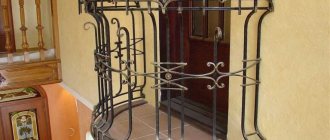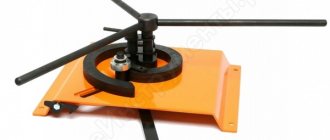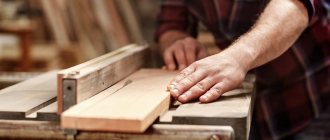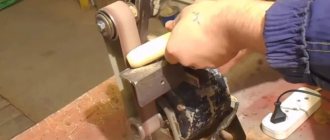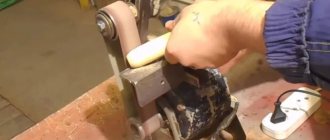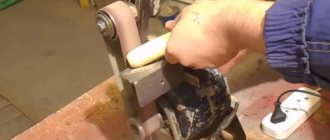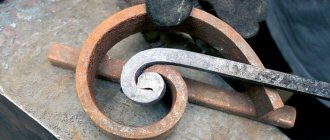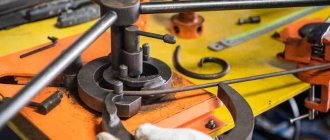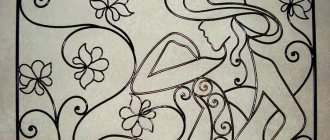One way to decorate areas is to use forged items. Fences, benches, gazebos, stair railings and other similar structures look very decorative. Moreover, in most cases, these products are not forging in its traditional sense. Most often, this is done not in a forge or with a hammer and anvil, but with the help of some devices that allow you to create a wide variety of patterns and products from metal strips and square rods. To make such products you will need cold forging machines. Some of them you can make with your own hands, others are easier to buy.
Fences, railings for stairs and balconies - you can also do it yourself
Canopy over the porch using cold forging
Porch railings are a decoration, not a purely utilitarian fixture.
You can make a gazebo and forged furniture
The gate looks magical
What kind of devices are used?
Cold forging is characterized by various curls, bends, twisted rods, etc. Almost every type is made on a separate device - a specific machine. They can be driven manually or electrically. For small volumes “for yourself”, manual cold forging machines are used. Although they are not particularly productive, they are much easier to manufacture. If it is necessary to put production on stream, similar devices are made, but with electric motors. In this case, there is almost no need to physically work, but the complexity of making the device increases significantly. In our material we will talk about manual machines for cold forging.
What devices are used:
- Torsion bars. With their help, tetrahedral rods or strips of metal are twisted in the longitudinal direction. The result is twisted columns, which are also called torsion bars.
This is what a torsion bar and the machine of the same name look like - Flashlight. On this device, the rod is also twisted in the longitudinal direction, but it is also additionally bent in the transverse direction. It turns out something similar to a flashlight. Hence the name of the device.
This is how they make a flashlight - Twisters or snails. Form flat curls of different diameters.
Device for cold forging snail - for forming curls - Bending machines or benders. Allows you to bend rods or reinforcement at the required angle anywhere.
For bending anywhere and at any angle - bending machines (bending machines) - Wave. In fact, this is also a bend, but of a more complex design - it allows you to change the direction of bending, obtaining wavy parts.
Machine "Volna" - for the formation of the appropriate relief - Devices for processing the ends of parts - inertial stamping machines or other home-made devices.
Machines for shaping the ends of rods. In this case - crow's foot
For a beginning craftsman, the most relevant machine for cold forging is a snail. Only with its help you can make many interesting things - from a fence and gate to a bench and other similar products. In second place in terms of necessity is a torsion bar machine. It adds variety to the details. All the rest can be purchased or made as you improve and gain skill.
Where to look and how to choose metal
Both non-ferrous and ferrous metals, such as steel, can be hot forged. The processing temperature depends on their physical and chemical properties. Titanium is forged at 900-1600 °C, iron at 800-1250 °C, copper at 650-1000 °C, aluminum at 400-480 °C. Steel is selected depending on the carbon content in its composition (GOST 380-71). Suitable brands are St0, St1, St2 and others. For the manufacture of art products, steel up to and 15 is usually used.
- Up to 0.1% carbon. Iron is soft, easily forged and welded using a special forge method.
- 0.1-0.3%. Ornamental metal is well suited for artistic forging.
- 0.08-0.85%. Structural steel is processed under proper heat. It hardens well, but welds poorly.
- 0.6-1.35%. High carbon steel, before and during forging, requires the blacksmith to have skill and knowledge of the heating steps. Tools are made from these raw materials.
- From 2.14%. Cast iron is hard and brittle. Only some brands can be forged.
Table 1. Determination of steel grades by spark
| Steel grades | Perception of spark |
| St2, St3 | The threads are thin, there are few branches of sparks |
| St4 | There are few branches, the threads are slightly thicker than St3 (St2) |
| St10 | The threads are sharp, there are few stars, the branches diverge slightly |
| St15, 20 | There are already more branches of stars |
| St20, 30 | The branches diverge even further |
| U8, U10 | The ends of the threads are thin, there are many stars and branches |
| U12 | The stars are dense and small |
| St40 | The branching is significant, the stars are round, the ends of the threads are sharp |
| St45N |
Soft and ductile aluminum is suitable for creating decorative parts: when heated, a protective oxide film appears on its surface. Copper is a universal material that can be forged both cold and hot: it is used to decorate antique compositions. Products made from brass look elegant, but the malleability temperature of this metal is in the range of 10 °C. Bronze is perfectly forged and has a beautiful shade: the material is in demand when decorating Gothic and classical interiors.
Important: Home craftsmen can buy rods and other rolled products for hot forging in specialized construction stores. But it will be cheaper and more practical to purchase a semi-finished product at a metalware warehouse for housing and communal services, at a scrap metal collection point, or at construction sites.
Homemade “Snails”
In essence, this is a modernized bending machine (pipe bender), but these improvements make it possible to easily make curls from fairly thick rods (up to 10-12 mm cross-section) and repeat them with a high degree of accuracy.
One of the homemade cold forging machines
These cold forging machines have several designs, but the easiest to implement is the one with a round table with a central leg. A lever with rollers on bearings at the end is movably attached to the leg. They make the bending process easier.
The table surface can be made of steel sheet with a thickness of 10 mm or more. For the leg, you can use any thick-walled round pipe. It is important to make the structure stable, since lateral forces will be applied, so side posts, spacers, and a stable base are needed.
Drawing of a cold forging machine “Snail”
It is easier to make a lever from a square pipe with a thick wall - at least 2-3 mm. The cross-section of the pipe is 25*40 mm or so. Attaching the lever to the leg can be done on a bearing, or you can simply take a small piece of thick-walled pipe of a larger diameter, put it on the leg, and weld a stop strip on the bottom so that the lever does not fall down. The option with a bearing gives easier movement, but if there is lubrication, the second option also works.
Lever mounting option
The shape of the lever is also important. The lever is double, the upper part is working, the lower part is supporting. Wherever there are connections, it is advisable to add reinforcement, since the efforts are significant.
The lever must be reliable, with reinforcement
A mandrel or jig is fixed on the table - the shape along which the curls are bent. They are made in different diameters so that you can make curls of different diameters. Such mandrels can be prefabricated to form a larger number of bends. Each such sample must have rods that are installed in holes in the table. This is how this template is fixed. Also, its shape must be designed in such a way that the end of the rod is well fixed in it.
Variant of conductors for the snail
Often, mandrels are machined from a metal circle of a suitable diameter using a grinder, but there are options made of metal with steel plates welded onto it, curved accordingly.
How to make a similar machine for cold forging is in the next video. There is also a good description of how to bring the ends of the workpiece to a decent state - ordinary raw edges look very rough. There is special equipment for processing them, but, as it turns out, you can do it without it.
Tools: backing tools
To punch holes in thick forged products, firmware and special punches are used, which, unlike punches, do not have handles, but are held by pliers. In the heads of hammers and sledgehammers, the holes are oval in shape and have a double-sided taper, which is formed when holes are punched using oval-conical broaches. First, the hole is pressed on one side of the workpiece, and then turned 180° and the hole is stitched on the other side. In a similar way, oval cylindrical holes are stitched in the heads of backing tools - punches, smoothers, rollers, etc.
It is known from blacksmith experience that to ensure that the piercing is removed from the hole being punched, a little fine coal is poured into a pre-marked recess and the gases that arise during the piercing seem to push the tool out.
Planers are designed to smooth out roughness on the surface of a forging after it has been processed with a hammer. Smoothing irons have flat and semicircular working surfaces of various shapes and sizes. Large surfaces are leveled with a trowel with a square working surface measuring 100x100 mm, and for small areas, trowels measuring 50x50 mm or with a rectangular surface are used. Flat irons with a cylindrical surface are used when smoothing dumbbells and radius surfaces, selecting the appropriate size. The material of the blades is steel 40, 45, 50. The surface hardness is 40-50 HRC, and the hardness of the upper part of the head is 30-40 HRC.
Rolling machines (pressures) are designed to accelerate the crushing of metal along or across an axis, as well as to knock out cylindrical grooves on workpieces.
The backing tool of group II has a square shank, which is inserted into the corresponding socket of the anvil. Backing tool of the second group: 3, 4, 5 special tool; 2cone; 6fork; 7cut.
Cuttings are used for chopping workpieces or cutting off parts of it using handbrake. The blacksmith places the workpiece on the cutting knife and, hitting it with a handbrake, chops off the necessary part, but not completely, so as not to spoil the cutting blade. Therefore, a deep hem of the workpiece is carried out, and the parts of the workpiece are finally separated at the edge of the anvil with a light blow of the handbrake. The cutting material is steel 50 with a working surface hardness of 50-55 HRC. The blade is sharpened at an angle of 60°.
Tapered mandrels are designed to widen holes in forgings, distribute rings and perform bending operations. Forks are designed for bending and curling workpieces. Mandrels - for forging slopes, bending and forge welding of chain links.
Group III paired backing tool. Backing tool of the third group: a - crimps: 1 - hexagonal; 2 - cylindrical; 3 - square; 4 - tamper; b - nail shops; c - blacksmith molds.
Designed to increase the productivity of blacksmiths and improve the shapes of forgings. The tool consists of a nizhnyak (lower tool), which is inserted into a square hole in the anvil with a square shank, and a upper part (upper part of the tool), which has a handle for holding.
This group includes paired crimps, for giving the pre-forged workpiece the correct cylindrical, rectangular or polyhedral shape, and tamps, intended for flattening (distributing) metal, both longitudinal and transverse. For work, tampers of various radii of the working part from 8 to 30 mm are used. Special artistic works are performed using crimps - stamps of complex relief shapes. Material of crimps, tamps and dies: steel 45, 50, U7. The hardness of the working parts is 45-50 HRC, and the hardness of the upper impacted part is 30-40 HRC.
A nail machine with flat hammers is designed for landing heads of various sizes and shapes of nails, bolts and rivets. The nailer itself is a separate form with a handle or a special plate with holes. To give the head of a nail, bolt or rivet the desired shape (sphere, prism, hexagon, etc.), flat hammers are used. Nailers are made by forging from steels 45, U7, U7A and heat treated to a hardness of 45-50 HRC.
Torsion bar machine
As already mentioned, these cold forging machines allow you to make longitudinal bends on the rod. This is a relatively simple design. The main task is to fix one end of the rod motionless, attach a lever to the second, with which you can twist the workpiece.
A piece of profiled pipe with a thick wall (at least 3 mm) is suitable as a base. The retainer can be welded from the same rods, leaving a square gap of the required diameter. You can use a properly sized cable clamp (available at a rigging store). Any of these stops is welded to the base.
Cable holder - great for holding rods
Next, you need to somehow ensure grip and torsion of the second part of the workpiece. This can be done using two bearing units. A pipe of a suitable diameter is inserted inside, and a handle is welded to it on one side - the design resembles the letter “T”. On the other hand, a clamp is made in the pipe: four holes are drilled, nuts for 12 or 14 bolts are welded into them. The result is a good clamp - the bolts are tightened after the rod has been inserted.
Bearing unit
Workpiece clamp
This is what the design looks like as a whole
Next - a matter of technique - use a lever to screw in the required number of turns. This is not to say that this work is for weaklings, but with a lot of leverage, everything is not so difficult.
An even simpler machine for making torsion bars using cold forging is in the next video.
Hot Forging Equipment
If we compare the cold and hot forging methods, we can say that the first method requires the worker to have greater skill, artistic skills and the ability to work with a set of necessary tools.
Forging of the material occurs after preheating in a forge furnace called a forge. The forge is equipped with equipment for forced air supply. Heating is carried out to a predetermined temperature, after which the product is transferred to the anvil. This is a metal plate where impact processing of a heated workpiece is carried out. It is performed using hammers and sledgehammers of different weights. One worker hits the desired place with a light hammer, and the second, with a heavy hammer or sledgehammer, delivers a strong blow to the designated place. After the workpiece has cooled, it is again loaded into the oven for heating. All movements of the part during its processing are performed using pliers with long handles.
In addition to the above-mentioned basic tools, hot forging uses many special tools that allow cutting hot metal and forming complex surfaces during hot forging.
Forge
Furnaces called forges are used to heat the workpieces. Its design includes several components:
- barrel made of fire-resistant material;
- hearth, with built-in grate;
- air supply and exhaust systems;
- working window where long workpieces are fed;
- a chimney through which combustion products are removed.
In addition, the forge also includes a quenching bath. The operation of a classic forge is based on the unique reducing ability of carbon. This ability successfully resists the oxidation of the workpiece, that is, its combustion. The calorific value of carbon is also important. When supplying air, you need to regulate its quantity. There should be enough of it to burn the carbon, and the heat generated will raise the temperature in the forge.
The air supply to the forge should be adjusted so that the supplied oxygen is not enough to oxidize the metal. But if the heated workpiece is kept in this state for more than the required time, then supersaturation with carbon will occur. There is such a term - overdrying. The metal becomes very brittle. Cast iron can be used as an overdried metal.
Muffle furnace
Equipment used to heat parts made of different materials to a given temperature is called a muffle furnace.
The difference between this equipment is the presence of a muffle. This is the name of the part that protects the workpiece from contact with fuel and combustion products and at the same time serves as a chamber where the part is heated.
In practice, two types of such furnaces are used, with a permanent and replaceable muffle. In one furnace, the loaded parts undergo all operations - from heating to complete readiness, in the other only until cooling. As the required temperature and a certain holding time of the workpiece are reached, one muffle is removed and another is put in its place.
It should be noted that both the forge and muffle furnaces can use different types of fuel - gas, coal, firewood, light and dark oil products, etc.
Anvil
One of the main tools used in both cold and hot forging is the anvil. It is on its surface that blacksmiths deform the workpiece and bring it to its finished form. The anvils are heavy and therefore rigidly fixed to a wooden block.
Structurally, the anvil consists of:
- horns;
- platband with holes;
- bases with paws for installing an anvil.
For the manufacture of such a tool, 45L steel is used. Anvils are products manufactured in accordance with GOST 11396-75 (standardizes hornless products weighing from 92 to 200 kg), GOST 11398-75 (defines requirements for products with two horns and weighing from 100 to 270 kg).
The hardness of the material from which anvils are made is 340 - 477 HB.
